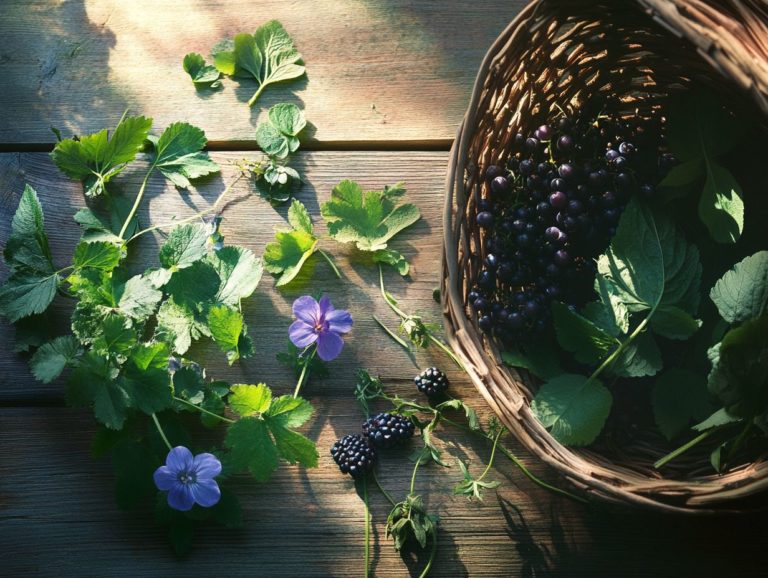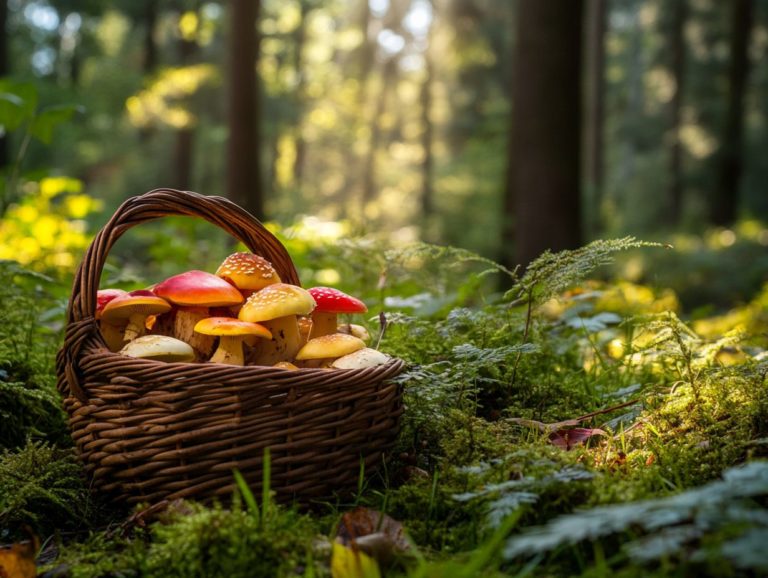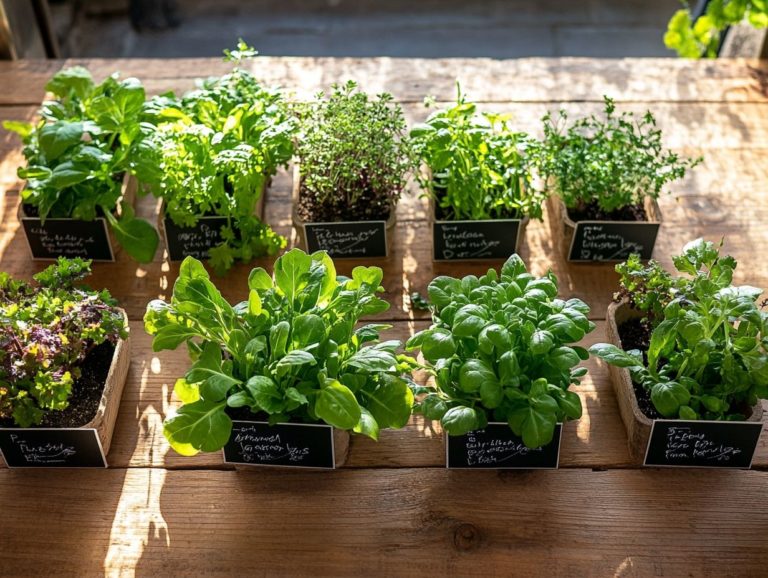The Science of Edible Fungi and Their Benefits
Edible fungi, often referred to as mushrooms, are not merely culinary treats; they are also brimming with nutritional benefits that can elevate your diet.
This article delves into the various types of edible fungi, showcasing their key nutrients and the health advantages they bring. You’ll discover popular dishes and inspiring recipes to seamlessly incorporate them into your meals, along with expert tips for growing and harvesting your own mushrooms right at home.
We will also highlight safety tips to help you enjoy these mushrooms safely.
Immerse yourself in this exploration and learn how to make the most of nature s generous offerings!
Contents
Key Takeaways:
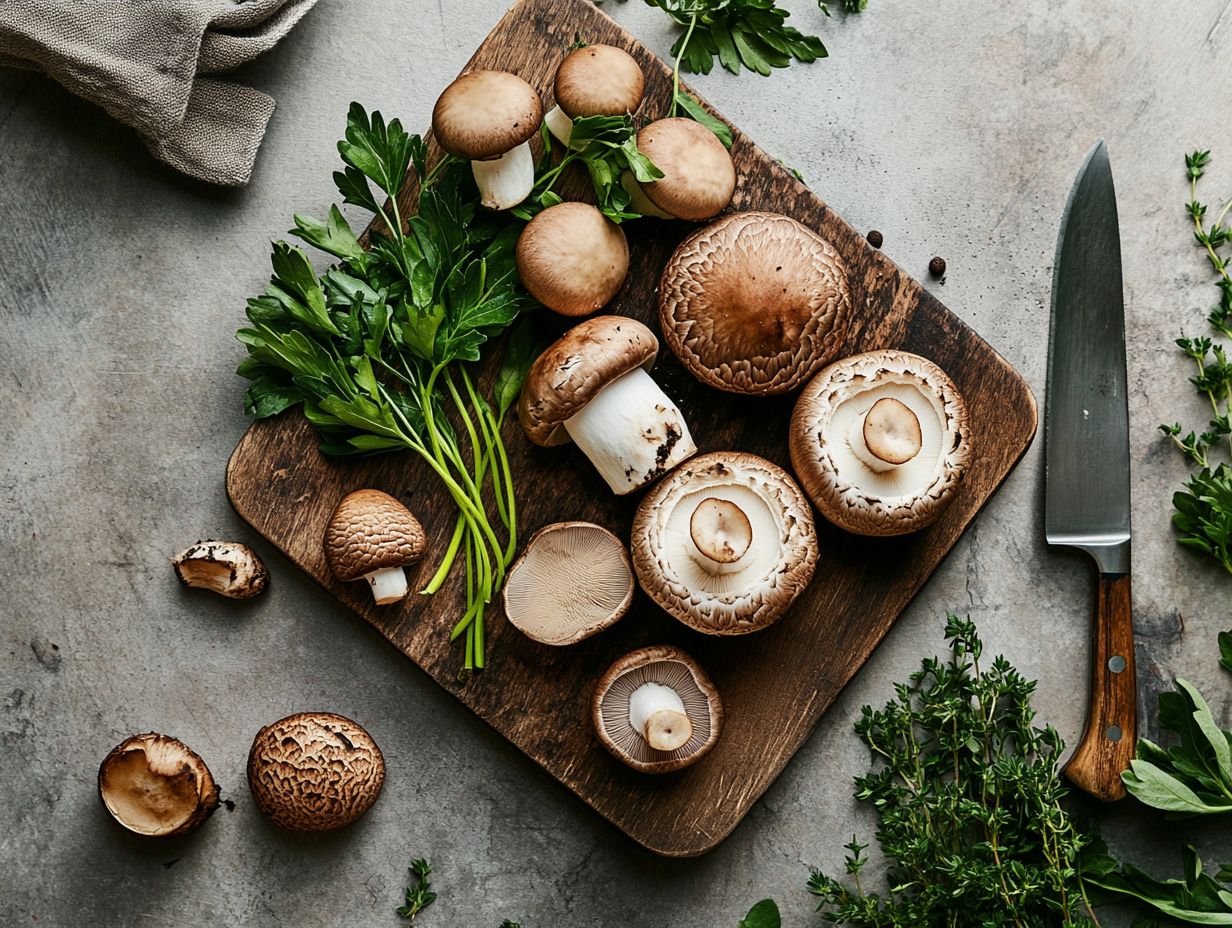
- Edible fungi are a diverse group of nutritionally dense foods that offer a range of health benefits.
- From stir-fries to soups, edible fungi can be incorporated into a variety of delicious dishes and recipes.
- While there are many edible fungi to choose from, including cremini mushrooms, it is important to properly grow, harvest, and handle them to avoid potential risks.
What are Edible Fungi?
Edible fungi, or mushrooms, come in many exciting varieties that elevate culinary experiences while offering remarkable nutritional advantages, appealing to your health-conscious palate.
These exquisite fungi present themselves in numerous forms, such as the robust portobello, the delicate enoki, and the richly flavored oyster mushroom. Their versatility allows them to shine in a multitude of cooking methods, transforming everything from stir-fries and soups to grilled dishes and gourmet risottos.
Beyond their delightful taste, mushrooms contribute significantly to a balanced diet that includes a variety of types of mushrooms boasting high fiber content and low calories. They stand out for their ability to enhance heart health and improve digestive wellness. They are also natural substances that can help reduce inflammation.
Discover the amazing health benefits of mushrooms that everyone is talking about! Edible fungi are increasingly recognized not just for their culinary allure but also as a nutritional powerhouse worth incorporating into your meals.
Nutritional Benefits of Edible Fungi
The nutritional benefits of edible fungi are truly remarkable, offering a wealth of vitamins, minerals, and antioxidants that enhance your overall health and well-being.
Rich in vitamin D, these edible mushrooms provide an excellent vegan source of this essential nutrient, crucial for promoting bone health and bolstering immune function, making them a valuable food source.
Additionally, their antioxidant content works to combat oxidative stress, while the protein found in fungi supports muscle repair and growth. This makes them an ideal choice for anyone looking to lose weight or gain muscle effectively.
Key Nutrients and Health Benefits
Mushrooms are packed with key nutrients, including essential vitamins, minerals, and powerful antioxidants that contribute to remarkable health benefits. They bolster your immune system and promote overall wellness. Take cremini mushrooms, for example; they are particularly high in selenium, which is linked to improved immune function.
Meanwhile, shiitake mushrooms bring unique antioxidative properties that can help counteract chronic health issues. When you regularly include these mushrooms in your diet, you may experience lower blood pressure and better nutrient absorption, making them a valuable addition to your meals.
Portobello mushrooms, for instance, are rich in B vitamins, which are crucial for energy metabolism and cognitive health. Compounds like ergothioneine and beta-glucans found in these fungi can enhance cellular function and reduce inflammation, offering cumulative benefits that support cardiovascular health.
By incorporating a diverse range of mushrooms into your meals, you can harness the synergistic effects of their nutrients, leading to noticeable improvements in cholesterol levels and overall metabolic health. This underscores the essential role mushrooms play in a balanced diet.
Start exploring these versatile mushrooms today and elevate your meals!
Culinary Uses of Edible Fungi
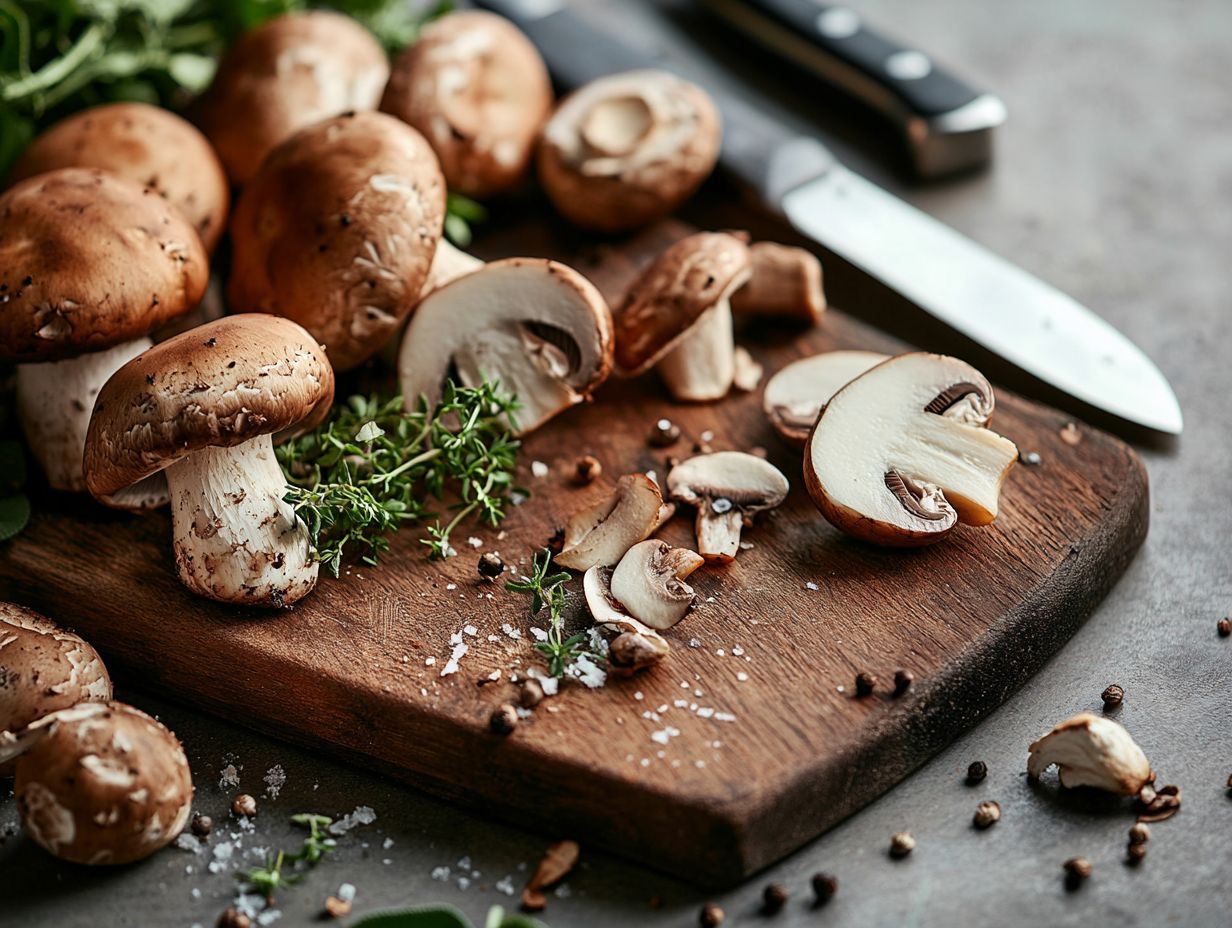
The culinary potential of edible fungi, including truffles and other varieties, is expansive and exquisite. They allow you to infuse many dishes with their distinct flavors and textures while boosting nutritional value.
Whether you’re enjoying gourmet creations featuring truffles or using familiar varieties like cremini and shiitake in everyday meals, mushrooms offer endless possibilities. They’re a low-calorie food that can be saut ed, grilled, or used as a meat substitute in vegetarian and vegan recipes.
How about grilling portobello mushrooms for a satisfying burger alternative? Their remarkable versatility makes them essential in cuisines worldwide, catering to the refined tastes of gourmet chefs and the creative flair of home cooks alike.
Popular Dishes and Recipes
Popular dishes featuring mushrooms span from vibrant Asian stir-fries to rich Italian risottos. They showcase the remarkable versatility of these edible fungi in the culinary realm. You’ll often encounter specific varieties like shiitake in ramen or porcini in risotto, each allowing their unique flavors to shine.
Mushrooms easily serve as a primary ingredient in vegetarian meals. They offer a hearty, protein-rich alternative to meat that caters to various dietary preferences.
Consider a creamy truffle mushroom pasta. It not only tantalizes your taste buds but also satisfies those in search of gourmet vegetarian options. A classic French mushroom soup provides warmth and comfort in any season.
With various cooking techniques from saut ing to roasting you can unlock the rich savory flavors inherent in different mushroom types, making them a perfect fit for vegan diets. These examples show how mushrooms fit into many types of cooking, ensuring every meal is both flavor-packed and inclusive.
Types of Edible Fungi
You ll find a remarkable variety of edible fungi, each boasting unique characteristics, flavors, and health benefits. From the familiar cremini and button mushrooms to the more exotic truffles and lion s mane, there’s something delightful for every palate.
Each variety has its distinct attributes think texture, taste, and how they enhance your dishes. Plus, they offer individual health perks, including immune support and antioxidative properties, enhancing both your meals and well-being.
Common Varieties and Characteristics
Common varieties of mushrooms, such as cremini, shiitake, and porcini, each possess unique characteristics that distinguish them in flavor, texture, and cooking applications. Cremini mushrooms, with their rich, earthy taste, prove versatile in salads and pasta dishes.
Shiitake mushrooms impart a distinctive savory flavor, making them a staple in Asian cuisine. Meanwhile, porcini mushrooms, celebrated for their robust flavor, often find their way into gourmet dishes, earning a special place among chefs and home cooks.
These mushrooms not only enhance the flavor of your dishes but also offer valuable nutrients. Cremini mushrooms are an excellent source of B vitamins and antioxidants, making them a nutritious addition to any meal.
Shiitake mushrooms, renowned for their medicinal benefits, are rich in polysaccharides that may bolster your immune system. Porcini mushrooms elevate sauces and risottos, enriching the overall culinary experience.
Understanding how to incorporate these varieties into your cooking can truly elevate your dishes while providing a host of health benefits, underscoring their significance in modern cuisine and holistic nutrition.
Growing and Harvesting Edible Fungi

Growing and harvesting edible fungi offers a truly rewarding experience. It empowers you to cultivate your own food while exploring the fascinating world of mushrooms.
Whether you choose to use home cultivation kits or embark on a wild foraging adventure, understanding how mushrooms grow and where they thrive is crucial for success.
With the right techniques and a bit of patience, you ll savor the fresh flavors and numerous health benefits of your homegrown or foraged mushrooms, enhancing your overall nutrition.
Tips for Cultivating at Home
Cultivating edible fungi at home can be both enjoyable and rewarding. Adhering to key tips promotes successful mushroom growth.
Begin by selecting the right mushroom species that aligns with your environment and skill level. Consider options like cremini or oyster mushrooms.
It s essential to provide adequate moisture, light, and temperature control. These factors play a significant role in the yield and quality of your mushrooms.
Utilizing readily available growth kits can greatly simplify the process. These kits include all necessary components, such as pre-sterilized substrates and spores.
If you’re inclined towards a DIY approach, focus on proper substrate preparation. Substrate is a material that mushrooms grow on, and options like straw or coffee grounds serve as excellent, nutritious mediums.
Be vigilant about monitoring humidity levels. Fluctuations can lead to contamination or hinder growth.
When encountering common issues like spotting or slow growth, check for appropriate air circulation and adjust moisture levels as needed.
By integrating these strategies, you can elevate your home cultivation experience and enjoy a delightful harvest.
Safety Considerations for Edible Fungi
Always keep safety in mind when handling edible fungi. This ensures a safe and enjoyable experience, whether you re cooking with store-bought mushrooms or foraging for them in the wild.
It s essential to familiarize yourself with safe and toxic varieties. Misidentifying mushrooms can lead to serious health issues.
Understanding proper handling, storage, and cooking techniques will significantly reduce potential risks associated with consuming wild or cultivated mushrooms.
Potential Risks and Precautions
Potential risks associated with consuming edible fungi can emerge from improper identification, handling, and preparation. Therefore, take the necessary precautions.
Some mushrooms closely resemble toxic varieties, and without the right knowledge, you could inadvertently consume harmful species.
Thorough research and education on mushroom identification, safe harvesting techniques, and proper cooking methods are vital for a safe culinary experience.
It’s crucial to be aware of specific characteristics that distinguish edible mushrooms from their toxic counterparts. Understanding the signs of toxicity can dramatically reduce health risks.
Familiarize yourself with local resources, such as guides or workshops, to enhance your understanding of safe practices. Consuming wild mushrooms without proper knowledge can lead to severe health issues, including poisoning or gastrointestinal distress.
As you embark on this fascinating journey of mushroom foraging, prioritizing education can ensure a rewarding experience.
Frequently Asked Questions
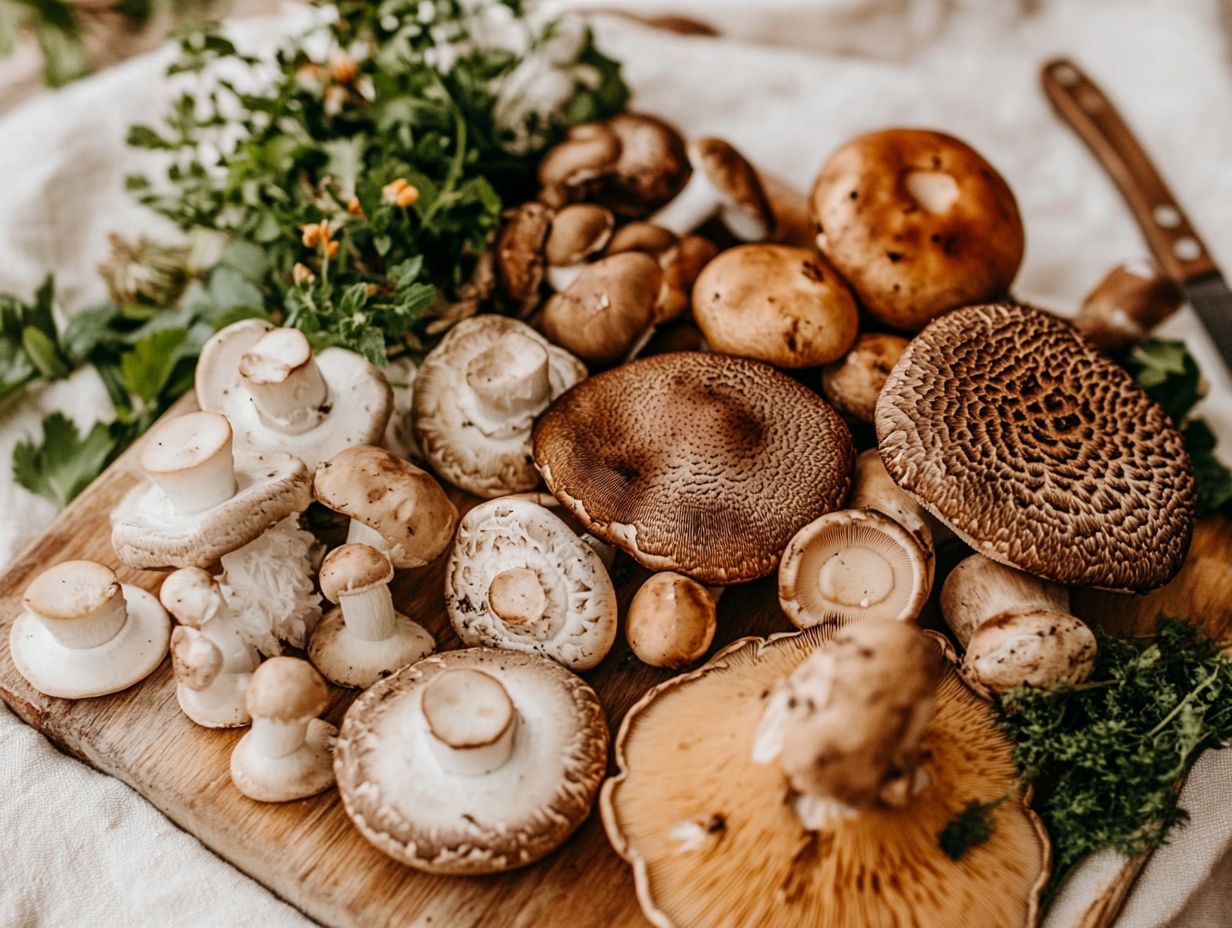
What is the science behind edible fungi and their benefits?
Discover the amazing science behind edible fungi! Learn about the types that are safe to eat and uncover their incredible nutritional benefits in the ultimate guide to edible fungi.
What are some common types of edible fungi?
Common edible fungi include mushrooms, truffles, and oyster mushrooms. They are packed with protein and antioxidants, helping boost your immune system and lower cholesterol.
How do edible fungi benefit our health?
These fungi are rich in vitamins and minerals. They are low in calories and fat, making them perfect for a healthy diet.
Can edible fungi improve brain function?
Yes! Lion’s mane mushrooms may help enhance memory and cognitive function. They contain compounds that can protect the brain.
What role do edible fungi play in traditional medicine?
In many cultures, edible fungi are used in traditional medicine. They can help treat inflammation, infections, and digestive problems.
Are there safety precautions when consuming edible fungi?
Most edible fungi are safe, but proper identification is crucial. If you’re unsure, consult an expert or skip it entirely!

